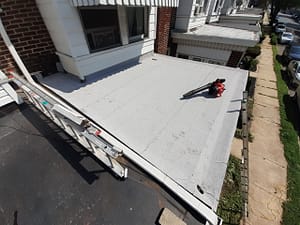When it comes to roofing options, flat roofing often gets a bit of a bad rap. Many people think of it as just a simple cover over a building, but there’s a lot more to it than that! As an experienced roofing salesman, I’ve seen the pros and cons of flat roofing up close, and I want to help you decide if it’s the right choice for your home or business. Let’s dive into the details!
What is Flat Roofing?
Flat roofing is exactly what it sounds like—roofs that are level or nearly level, rather than pitched. Common materials used for flat roofs include TPO, EPDM, PVC, and modified bitumen. You’ll often see flat roofs on commercial buildings, but they’re becoming increasingly popular in residential settings too, especially for modern designs.


Why Choose Flat Roofing?
Many homeowners and businesses are opting for flat roofs due to their unique benefits. However, it’s important to understand both the advantages and disadvantages before making a decision.
Pros of Flat Roofing
Cost-Effectiveness
One of the biggest draws of flat roofing is its cost. Generally, flat roofs are cheaper to install than pitched roofs. A few years ago, I worked with a young couple looking to buy their first home. They were on a tight budget, and a flat roof allowed them to save money upfront. They loved the extra cash for renovations instead!
Long-Term Savings
Flat roofs can also be cost-effective in the long run. With fewer materials needed and a simpler installation process, you may find maintenance costs to be lower, especially if you stay on top of inspections.
Versatile Space Utilization
Flat roofs offer unique opportunities for additional usable space. Imagine turning your rooftop into a garden, patio, or even a spot for solar panels! I had a client who transformed their flat roof into a stunning rooftop lounge complete with plants, seating, and even a small grill. They loved hosting summer get-togethers up there!
Easy Accessibility
When it comes to maintenance, flat roofs are generally easier to access than their pitched counterparts. This means routine inspections and repairs can be done with less hassle. I once climbed up to inspect a flat roof for a local business owner, and it took me just a few minutes to identify a minor issue that could have turned into a big problem if left unchecked.
Modern Aesthetic Appeal
Flat roofs can give homes and buildings a sleek, contemporary look. Many modern architectural designs incorporate flat roofs for a minimalist vibe. If you’re going for that trendy, urban feel, a flat roof might just be your best bet.
Cons of Flat Roofing
Drainage Challenges
One of the main drawbacks of flat roofing is drainage. While they may be level, water can pool if not properly designed. I remember working with a homeowner who thought their flat roof was great until heavy rain caused water to collect. They had to invest in additional drainage solutions to fix the issue. Proper drainage systems are crucial to avoid potential leaks and water damage.
Shorter Lifespan
Flat roofs tend to have a shorter lifespan than pitched roofs, typically lasting 10-20 years depending on the materials used. During my time in the industry, I’ve seen more flat roofs requiring repairs or replacements compared to their pitched counterparts. It’s important to consider how long you plan to stay in your home when evaluating a flat roof.
Temperature Sensitivity
Flat roofs can also be more susceptible to temperature changes. They may experience more heat in the summer and cool down quickly in the winter, which can affect insulation. A client of mine had a flat roof that made their house too hot in the summer, leading them to invest in additional insulation to keep things comfortable.
Maintenance Requirements
While flat roofs are generally easier to access, they do require regular maintenance to prevent leaks and damage. Keeping up with cleaning, inspections, and repairs is essential to prolong the life of your roof. I had another client who neglected regular checks and ended up facing a major leak during winter, which resulted in costly repairs. Don’t let this be you!
Is Flat Roofing Right for You?
Yes, it depends.
When considering whether flat roofing is right for you, think about the following factors:
- Climate: If you live in an area with heavy rain or snow, make sure you understand how flat roofing will handle those conditions.
- Budget: Weigh the upfront costs against long-term maintenance and repairs.
- Aesthetic Preferences: Do you prefer the modern look of a flat roof, or does a pitched roof suit your style better?
Consult a Professional
It’s always a good idea to consult with a roofing professional who can provide tailored advice based on your specific situation. They can help you weigh the pros and cons and determine the best roofing solution for your needs.
Conclusion
Flat roofing has its advantages and disadvantages, and it’s not the right fit for everyone. However, with its cost-effectiveness, versatility, and modern appeal, it can be a fantastic choice for many homeowners. Just be sure to keep an eye on maintenance and drainage issues!
If you’re considering a flat roof, take the time to weigh the pros and cons. Talk to a roofing professional, and make an informed decision. Your roof is a significant investment, so choose wisely!
